Meal 56: Equatorial Guinea
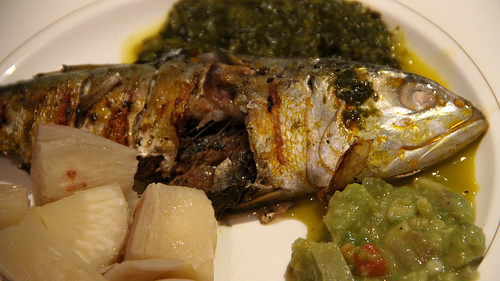 Despite its name, none of the country lies on the Equator. Most of its land mass is on the African mainland, but the capital's on an island. Its colonial language is Spanish, but French and Portuguese are official languages too. It's the richest country per capita in the continent, thanks to a recent oil discovery, but most of the population lives in poverty.
Despite its name, none of the country lies on the Equator. Most of its land mass is on the African mainland, but the capital's on an island. Its colonial language is Spanish, but French and Portuguese are official languages too. It's the richest country per capita in the continent, thanks to a recent oil discovery, but most of the population lives in poverty.
That's a lot of contradiction for a very small country — its population is barely 700,000. But improbably, we know someone who spent three years living there when his father was the US ambassador to Equatorial Guinea. Stephen was an excellent guide to the culture, politics, and foodways of a country few people have even heard of. The food was pretty much reminiscent of other nearby countries — peanuts, palm products, etc. — though with a bit of Spanish flair and probably more spice.
Our guests on this decidedly un-tropical, post-snowstorm night were Rafi, Laura, Craig, Marcy, Stephen, Chrys, and Jeremy.
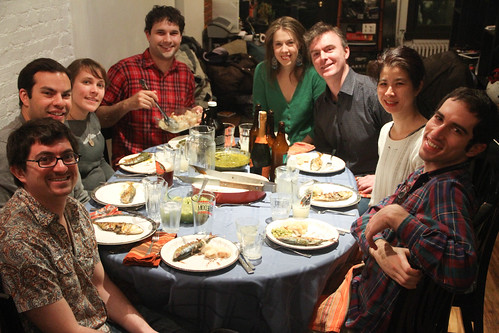
Vino de palma | Palm wine

This mildly alcoholic (~2%) beverage is brewed not from coconuts, but rather the same fruit that is pressed for palm oil. It's pretty sweet, almost like a cider, except with that distinctive palm-y flavor. This sort of thing is typically homemade, but Stephen managed to find a bottled version from Nigeria. Since we were out of space in the fridge, we turned to the great outdoors refrigerator to keep them cold — an incredibly incongruous technique given that the temperature never gets below the 70s there.
Pescado con dos salsas | Fish with two sauces | Recipe
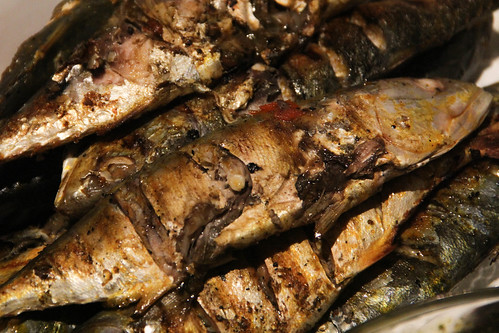
All manner of fish, big and small, is thrown on the grill in Equatorial Guinea. By using small mackerel, I split the difference: the mackerel has the rich flavor of a bigger fish, but the small aspect makes for a faster, crisper grilling, reminiscent of Spanish-style sardines. I cut slits in the skin to let the chili-garlic-lime marinade seep in and also to ensure more even cooking. To prevent sticking and to add flavor, the recipe calls for painting the fish with palm oil before grilling. Barbecuing in freezing weather was a bit of an adventure, and I had to clear the snow off the porch to do it, but it was well worth the effort.
Salsa verde | Spinach sauce
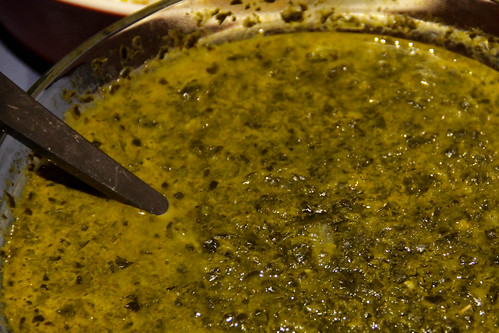
Apparently it's common to serve sauces along with grilled fish. The recipe suggested three; I skipped the peanut sauce because that was accounted for with the chicken. Another sauce is a moderately spicy green sauce, traditionally made with a local vegetable for which spinach was a suggested substitute. While the flavors were fine, it was definitely too watery; if you choose to make this I'd cut down on the liquid by half or so.
Salsa de aguacate | Avocado sauce
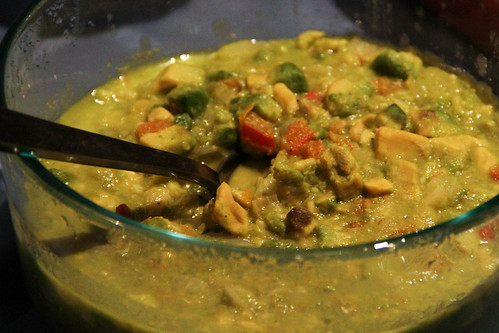
I found the avocado sauce more interesting and tastier. Avocado is one of those foods that is treated very differently around the world. In the US and in Mexican cuisine it's treated as a vegetable, always eaten raw. In Brazil and several other tropical countries, it's thought of as more of a mild fruit, frequently mixed with sugar and maybe milk into a drink. But in Equatorial Guinea, apparently they cook it! This dish was essentially a gently simmered guacamole, and surprisingly the texture of the fragile avocado held up.
Contrichop con arroz | Chicken in peanut sauce over rice | Recipes: Chicken, rice
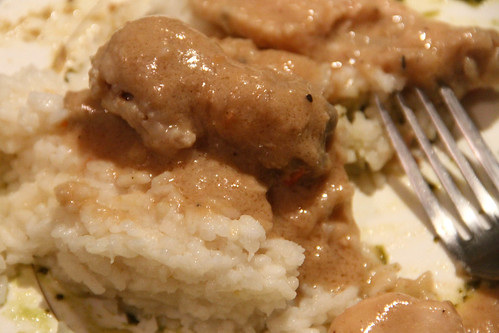
This is far from the first time we've had chicken-in-peanut-sauce, but this one has a bit of a twist. The chicken itself is very mildly cooked; this is the most elaborate recipe I found and even so it's little more than onions, chicken, and peanut butter. (Once again, I think it had too much water; in the end I removed the chicken and cooked down the sauce to get it to gravy thickness.)
The spice came not from the sauce, but from the rice — which is cooked in a risotto-like way, by first dry-frying the rice and then adding in water a bit at a time. As with risotto, it makes for a mushy mass. Perhaps this is a technique to have the rice absorb more water and therefore be more filling? Or maybe the cooking culture just doesn't like lids? Hm.
Kongodo | Peanut brittle | Recipe
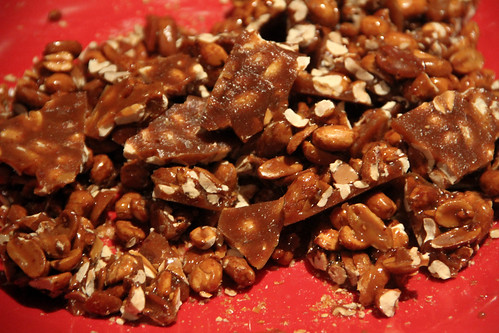
Turns out, peanut brittle is really easy to make. Essentially you toast peanuts in a dry pan, pour in some sugar mixed into water, and stir constantly until it caramelizes. This recipe adds a tropical twist with "a few drops of lime juice," I used half of a half of a lime but couldn't taste it at all, so if you try it, use more! We enjoyed this sweet treat with a papaya, mango, and guava salad.
Next we're heading to somewhere more appropriate to the chilly weather we've been experiencing...Estonia!
Photos by Laura Hadden, whose favorite part of the meal was a post-dessert donut from the fridge.